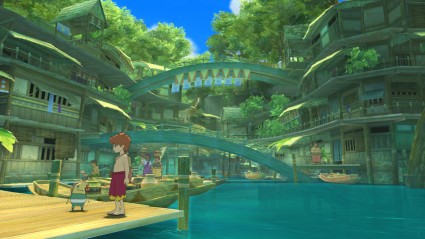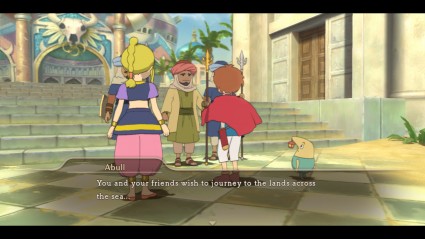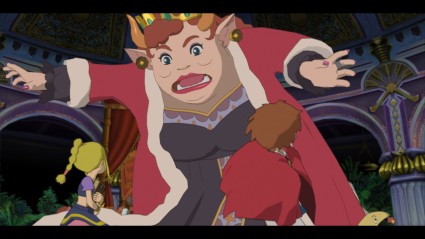Reviews
Ni No Kuni: Wrath of the White Witch
March 7, 2013, Author: Andy Corrigan
While I adore almost everything that Studio Ghibli have put out over the years, I’ve never had the pleasure of experiencing a Level 5 JRPG before, only managing to recently play and review their latest Professor Layton effort on 3DS. However, the idea of Ghibli collaborating with any game studio is one that I can firmly get behind.
In doing just that, Level 5 have absolutely managed to live up to the expectations cast over them by Ghibli’s impressive heritage. They’ve delivered a masterpiece.
Like Harry Potter, but good!
Ni No Kuni’s hero, Oliver, begins the game living gleefully in the quaint little town of Motorville. He’s a remarkably happy child, blessed with a caring mother and friendly neighbours who look out for him almost as much as she does; he almost has the perfect life. Like all little boys, though, he has a mischievous side that occasionally manifests, especially when in the presence of his best friend; in his case, the car-obsessed Phil. Unfortunately, that mischievous side is going to cost him dearly when a secret, late-night excursion goes horribly awry.
Without spoiling the finer details, Oliver’s happy little life is dealt a sickening blow as his mother is taken from him due to his own irresponsibility. He descends into sadness, until his tears magically bring his favourite stuffed toy to life. The toy, who introduces himself as Mr Drippy, claims to be a noble fairy from another world, a world that needs the help from one pure of heart to destroy a relentless evil known as Shadar. You guessed it; Oliver is the pure-hearted one.
Oliver is reluctant, too ready to keep wallowing, but when Drippy offers hope that his help in the other world could bring his mother back from the dead, he decides it’s a journey he must take. There are many people he must help before he can help himself, however; and I really can’t say much more than that without spoiling a magical adventure.
I have to say at this point, that Oliver managed to strike a real chord with me for reasons I disclosed recently in a pretty spoilerific piece for IGN.com. To be honest, I thought that I would hate him as a protagonist. Instead I found him to be a refreshing new breed of hero that never once conformed to genre stereotypes. The game’s theme of mending the broken-hearted is also deep, charming, constantly endearing and resonates in a number of unexpected but beautiful ways.
It’s a story with a message and meaning that’s entirely heart-warming to breathe in.

Ollie visits some amazing places in the other world…
We’re in the business of mending broken hearts!
When talking about JRPGs, I’m always one of the first to speak up and say that I’d like to see more developers play around with the genre’s conventions. Occasionally, though, a game will come along and remind you exactly why the old formula was so fun to begin with. Ni No Kuni definitely falls in to that category. It’s a classic-styled JRPG in almost every genre sense, but it does everything so exceptionally that it’s impossible not to enjoy it.
As soon as you set foot in the realm of Ni No Kuni, you’ll find yourself exploring a huge, exquisitely crafted world map, fighting monsters on the way to key towns and dungeons as Ollie sets about trying to become a wizard powerful enough to beat Shadar.
In terms of the game’s overall structure, I may be alone in saying that I found it to be very Zelda-like, seeing you head to a town or destination that’s notable or in trouble, before fighting through a nearby dungeon to beat the boss that’s giving the locals some grief. It’s never quite as formulaic in execution as I’ve made it sound, though.
Like many games these days, Ni No Kuni takes a leaf from the book of Pokémon and lets you capture, tame and use the world’s many creatures in combat, and these are known as ‘Familiars’. This isn’t just a side element, either, as keeping a set of Familiars levelled up with you is essential part of combat. How deep into this system you go beyond that is entirely up to you, however.
You can obsessively collect different familiars or stick with a bunch of favourites, keep them fed with their favoured treats to increase your bond and their attacks, plus keep their gear up to date; their inclusion is flexible and rewards experimentation. Each party member can only carry three Familiars at a time, though, so it’s best to make sure you have a rounded selection.
As with Pokémon, every familiar can metamorphose up to three times when they hit a certain level and subsequently get fed the right type of stone, allowing you to improve and tailor their skill-set as you progress. Unlike Pokémon, however, you don’t have to keep using one in particular to keep it levelling up alongside you. As long as you have them in a character’s mini-party, they’ll level up whether they get used or not, and independently of their master’s own progress.
The combat system itself is the only aspect that doesn’t feel like a classic-style JRPG, falling between the old turn-based system of old and the real-time systems of new, but not totally unlike the system found in Eternal Sonata. When thrown into combat, you can choose to directly control any one of your party members or their familiars and you’re free to run around the arena, keep your distance and physically dodge attacks. Each of your attacks has its own cooldown period preventing you from spamming the same attacks over and over, but you can keep the pressure up by varying your assaults.
Each Familiar has one of four celestial symbols assigned to them, and that sign dictates their effectiveness against other creatures. For example, a Sun Familiar will do increased damage to a Moon-based creature, while a Star creature will be susceptible to additional damage from Moon, but will be more effective against Sun. It’s a balancing act that has a part to play early on; however, as long as you keep on top of your party’s level as you play through, it becomes less of a deciding factor in the outcomes of battles the more you progress.
The boss fights are really the only battles where the lineage of your familiars is ignored completely, though, and this is where most of the combat strategy will appear. Each boss has its own trick or gimmick to bringing it down, and working out that strategy (despite the obvious hints from Drippy) is something that I derived a lot of joy from.
Of course, this being a JRPG, your eventual success or failure in these fights comes down to one thing: your level. If you’ve not prepared or levelled enough by putting the time into some grinding, you’re going to have a bad time trying to rush through the story. Thankfully, the game isn’t anywhere near as grind-heavy as others of its ilk, but that’s not to say that you can ignore it completely.
Ni No Kuni does at least offer some hints as to when you’re in the right ballpark level-wise. Walk into an area underpowered and the enemies will charge you, constantly triggering battles. Walk in overpowered and they’ll run in fear, giving you an indication of how you’ll fare in areas ahead. It’s simple but effective sign-posting that made this JRPG flow brilliantly for me, whereas in others it’s easy to get ahead of yourself for the sake of story and find yourself struggling heavily on the next section or boss. If you keep a track of this simple indicator, you’ll find the game excellently paced, rarely stopping you with a brick wall of difficulty.
The game sees a slightly different approach to side-quests in that (in most cases at least) their success offers Ollie no XP for their completion. Instead, he will get a number of stamps on a coffee-shop style rewards card. Once he has enough completed cards, they can be exchanged for perks, such as increased XP in battle, a quicker run or more loot from enemies, which is valuable if you’re going to make regular use of the alchemy component.
In both side-quests and story missions, Ollie will need to make good use of his ever-increasing list of spells and solve problems for the good folks of both worlds. Sometimes, this means selecting the right spell to solve a particular issue, but for the most part you’ll be mending broken hearts.
In side-quests in particular, this is a simple process; find someone who’s lacking a human quality, such as enthusiasm, confidence or love, borrow some from someone who has too much of that quality and top up the afflicted heart. The story missions take this to a whole new level, though, seeing Ollie travel back and forth between the two worlds, helping someone in one world to fix their soul-mate in another.
It’s a simple mechanic that sits remarkably well with the game’s charming overall theme.

Ollie will mend the hearts of many in his journey to save his mother.
Looking familiar…
So often when reviewing Eastern-developed games with animated scenes or cel-shading, I’ve resorted to glib phrases about them looking like ‘Studio Ghibli movies’. The reason is simple; Studio Ghibli are absolute masters at their craft with a characteristic charm that’s unrivalled, and when a game pulls off a charming animated look that seems to aspire to Ghibli’s class, it’s going to pull comparison. Here it’s not a glib comment, though, as this is absolutely a Studio Ghibli production in design, and it looks phenomenal.
The game represents a master class in visual design, from its colourful, fascinating cast to a flawless world in which everything feels full of life; every single element feels lovingly crafted. It’s not a game that’s afraid to mix things up either, with its clean, crisp anime design in towns and dungeons making for a lovely contrast when compared to the almost painterly feel of the overworld.
At intervals throughout you’re treated to elegant Ghibli animated cut-scenes, depicting some of the major events in Ollie’s adventure, whilst the majority, understandably, resort to the familiar cel-shaded models of the gameplay. Here, though, the gameplay matches the cut-scenes extremely well, and it’s definitely less jarring than other games that have taken this approach previously.
Simply put, it’s a beautiful game no matter where you’re looking.
The magic of Joe Hisaishi
Responsible for some of the most amazing soundtracks in animated movie history, Ghibli fans will be delighted to know that Joe Hisaishi is behind Ni No Kuni’s sweeping orchestral score, and… it’s… glorious. It’s been a week since I finished the game, and still its theatrical themes ring around my head in moments of quietness. It’s truly inspiring how perfectly it nails the emotional ups and downs of Oliver’s journey.
Upon starting the game you’re given the choice between English or Japanese voiceovers (the latter with subtitles), but no matter which you opt for you’re in for a sure treat. While there’s a definite charm in the Japanese voice track, you’d be missing out on the Welsh-inspired genius of Mr Drippy, who is a constant delight throughout. That’s not to put a dampener on the rest of the cast; everyone does terrifically.

Look out, your Moojesty!
A JRPG for the ages…
I’m a picky JRPG player these days and it’s rare when one can provide me enough reason to see it through to the end. When I do see one through to completion, it tends to be down to the story and thankfully, Ni No Kuni: Wrath of the White Witch delivers a powerful tale, one that unexpectedly focused on a subject very close to my heart.
Story aside, the game excels in providing a classic adventuring experience, mixing exploration with solid combat, plus lots to see and do and a compelling reason to do it all. It was never once a chore; always a delight, right up to the end.
Honestly, I rate it as one of the best RPGs I’ve ever played, and I don’t say that lightly. If you’ve got 40-60 hours to spare, you’ll find a relevant, breathtaking game ready to whisk you away on one hell of an adventure. As Drippy would say, it’s “proper tidy”.
Platforms: PS3 | Tagged Drippy, Level 5, Mr Drippy, Ni No Kuni, Ni No Kuni: Wrath of the White Witch, Oliver, Proper Tidy, Tidy



